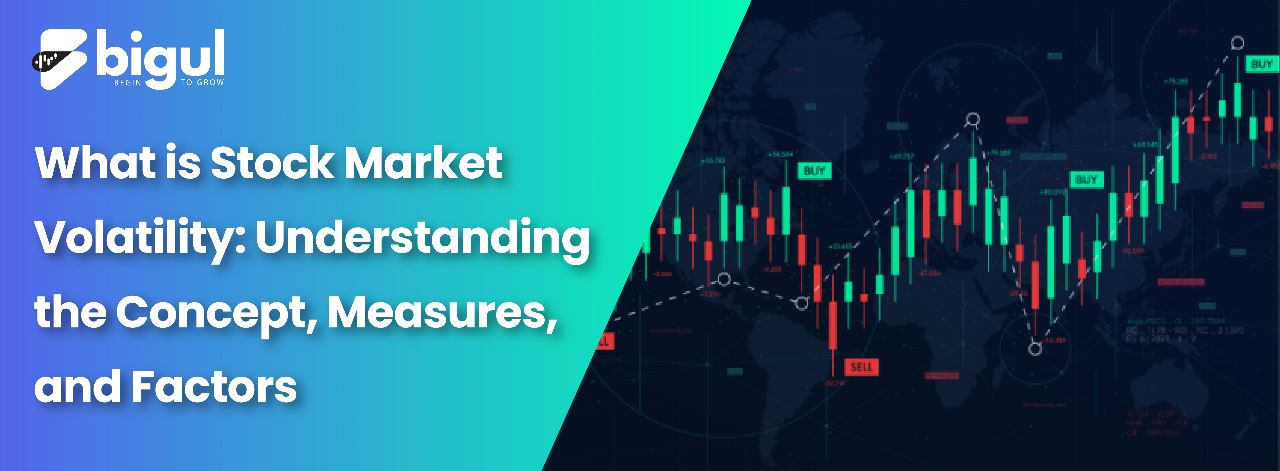Familiarity with the stock market undoubtedly brings the term “volatility” into one’s vocabulary. It’s commonly associated with risk or unpredictability regarding market movements. In this guide, we demystify what volatility means in the stock market context, including its basics, types, and commonly asked questions.
Understanding Market Volatility
In the context of the stock market, volatility is the under which the price of a security fluctuates for a specific set of returns. It serves as a metric of the risk linked to the price shifts of security. It is estimated by determining the standard deviation of the annualised returns over a certain period. In simple words, a measure of the pace at which the price of an asset, index, or whole market advances or declines is volatility.
Volatility is usually gauged using either standard deviation or variance. The larger the value, the more volatile the prices or returns are. This indicates that a high standard deviation value suggests a broad range of prices, while a low value signifies that prices are closely concentrated over a narrow range.
In stock market terms, swift price changes in any direction equate to volatility. Consequently, a high standard deviation indicates that prices can significantly rise or drop and vice versa. A change of 1% in market indexes usually tags it as a “volatile” market.
It’s worth noting that volatility is not a single concept or measurement but has multiple facets.
Exploring Historical Volatility
As its name indicates, historical volatility measures volatility over an extended period based on past price or return movements. It’s often referred to as statistical volatility owing to its heavy reliance on quantitative measures.
Investors typically use historical volatility to assess a security’s past performance based on its underlying asset’s price movements over various timeframes.
An increase in historical volatility suggests that the prices of the tracked securities are likely to fluctuate more extensively than usual. Conversely, a decrease in statistical volatility indicates that price movements will likely be more contained and show a minor deviation from the mean or average.
Concept of Implied Volatility
In contrast to historical volatility, implied volatility serves as a forward-looking measure, forecasting potential movements in securities’ values.
Investors worldwide utilise implied volatility to anticipate a stock’s possible trajectory, independent of historical data. This is a key determinant in pricing options contracts, with analysts considering various factors to predict potential shifts in securities’ prices. Implied volatility is often expressed in percentage terms but doesn’t specify the direction of price movement.
A high implied volatility value merely signals that the price of a particular security could experience a substantial change, either increasing or decreasing. On the other hand, low implied volatility suggests that the specific security is likely to see minimal price variation apart from minor fluctuations.
In terms of stock market applications, a bearish market typically exhibits a higher implied volatility rate than a bullish market. The rationale is that in a bullish market, investors anticipate prices to ascend gradually over time, thus causing implied volatility to decrease. In contrast, in a bearish market, implied volatility tends to rise as prices are expected to drop over time.
- Implied volatility with regard to options contracts
The Role of Implied Volatility in Options Contracts
Options contracts come in two forms – call and put. In a call option, an investor reserves the right to buy stocks at a predetermined price within a specified timeframe. Conversely, a put option permits an investor to sell stocks at a given price before the contract’s expiration.
The implied volatility of the security underlying an options contract is instrumental in pricing the contract. One prominent model for pricing these contracts is the Black-Scholes model. It considers the implied volatility of the underlying asset, its current market price, the strike price, and the contract’s expiration date to ascertain its price.
Various Measures of Volatility
Beyond standard deviation and variance, there are other ways to measure volatility, such as:
Beta: This demonstrates the relationship between a stock’s value and its corresponding market index, providing a tangible representation of stock volatility. Beta indicates the expected volatility in the returns of securities compared to their relevant benchmark index.
For instance, a stock with a beta value of 1.2 related to the Nifty 50 index signifies that a 100% change in the Nifty 50 index would lead to a 120% shift in that stock’s value. A higher beta value indicates a stronger correlation with the index and, thus, higher volatility, implying greater market dependency.
Volatility Index (VIX): Developed by the Chicago Board Options Exchange, VIX relies on investor expectations about the movements of specific securities or the broader market. A higher VIX suggests a more volatile and risky market, and vice versa.
What Does a Volatility Smile Indicate?
A volatility smile is a graph that forms by plotting implied volatility against the strike price of a group of contracts, all with the same underlying asset and expiration date. Implied volatility decreases as an underlying asset transitions from out-of-the-money to in-the-money and vice versa, reaching a low point at the money, then increasing. This creates a ‘smile’ shape on the graph.
What is a Volatility Skew?
A volatility skew appears more slanted than a balanced volatility smile. It demonstrates the varying implied volatility between out-of-the-money, in-the-money, and at-the-money options. This skew is visible when one event is assigned higher implied volatility than another.
Factors Influencing Volatility
Several factors can affect the volatility of the stock market and individual securities, including:
- The balance of supply and demand for securities
- Geopolitical conditions within an economy
- Socioeconomic factors
- The expiration date of an options contract
It’s crucial to note that market volatility doesn’t necessarily equate to losses; it represents risk. Experienced investors can use market volatility to their advantage, strategically employing their options contracts for substantial gains or as a hedge against potential losses.








.jpg)
.jpg)
